-
-
 Energy and Climate Databases
Energy and Climate Databases- The most comprehensive and up-to-date annual energy database.
- Monitoring of technology providers in H2 supply chain.
- Monthly energy data on key energy markets.
- The most reliable and up-to-date power generation database.
- The essentials of LNG trade at your fingertips.
- Global monitoring of new and existing refineries.
- Analyse energy consumption and efficiency trends at world level. Benchmark countries.
- Have your database developed by a recognised expert of both energy and IT.
-
 Energy - Climate Forecasts
Energy - Climate Forecasts- Instant access to energy and emissions forecasts.
- Strategic, annual wholesale price projections backed by Enerdata's energy modelling expertise and our globally recognised POLES model.
- Wedges module showing a breakdown of the levers enabling to reduce emissions between two scenarios.
- Unique, independent projections of consumption by end-use.
- GHG Marginal Abatement Cost Curves.
- Benefit from proven models to draw your own energy scenarios and anticipate tomorrow’s challenges.
-
 Market Intelligence
Market Intelligence- 110 Energy and climate country reports
- A newsletter to receive the latest updates on evolving technologies and policies.
- Global energy news and analyses curated daily.
- Enerdata’s experts bring you the essentials about your market and competitors.
-
-
-
 Market Analysis
Market Analysis- Understanding key consumption trends and drivers across sectors.
- Granular and exclusive insight to address the most pressing business and strategic issues.
- Expertise in strategic and business intelligence, with fine-tuning to the market’s specificities.
-
 Energy - Climate Scenarios
Energy - Climate Scenarios- Providing the outlook of an energy commodity in mid to long term time horizons.
- Sector and driver specific energy demand forecasting.
- Assess the evolution of energy prices on the international and regional markets, as well as end-users prices.
- Enerdata guides you through pathways to reach climate targets.
- Supporting local authorities in their decarbonisation strategies.
-
 Climate Strategy and Policy Evaluation
Climate Strategy and Policy Evaluation- Cutting-edge quantitative tools and relevant indicators to monitor and evaluate evolutions on worldwide energy markets.
- Analysis of the most cost-effective options to reduce emissions.
- Quantified simulation and analysis of pledges for climate change negotiations.
- Breakdown and analysis of carbon markets.
- Enerdata guides you on the most beneficial policy or investment options.
- Turning climate objectives into concrete action plans.
-
 Training
Training- Understand different policy targets and measures on energy efficiency.
- How to measure energy savings?
- Energy Forecasting is a 2 days training to learn to design and interpret energy forecasts.
- Energy statistics training allowing to create energy balance with supply, transformation and consumption and understanding the international energy statistics regulations.
- Initiation to EnerMED level 1is the training to approach on the most powerful energy demand forecasting model.
-
-
Resource Centre
Japan Key Figures
- Population:
- 125 million
- GDP growth rate:
- 1.92 %/year
- Energy independence:
- 16.5%
Data of the last year available: 2023
- Total consumption/GDP:*
- 67.8 (2005=100)
- CO2 Emissions:
- 7.64 tCO2/capita
- Rate of T&D power losses:
- 4.93%
* at purchasing power parity
View all macro and energy indicators in the Japan energy report
Japan Related News
View all news, archive your new and create your own daily newsletters only on your topics/countries of interest with Key Energy Intelligence
Japan Related Research
Benefit from up to 2 000 up-to-date data series for 186 countries in Global Energy & CO2 data
A data overview is available in the global energy statistics app
Total Energy Consumption
Energy consumption per capita was 3.1 toe in 2023. Electricity consumption per capita was around 7.3 MWh.
In 2023, total energy consumption dropped to 391 Mtoe (-3.5%). A downwards trend has been observed since 2010 (-2%/year), except a strong rebound in 2021 following the Covid crisis.
The energy intensity is decreasing rapidly (-2.6%/year since 2010).
Graph: CONSUMPTION TRENDS BY ENERGY SOURCE (Mtoe)
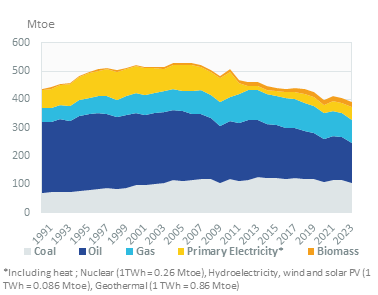
Interactive Chart Japan Total Energy Consumption
Benefit from up to 2 000 up-to-date data series for 186 countries in Global Energy & CO2 data
View the detailed fondamentals of the market at country level (graphs, tables, analysis) in the Japan energy report
Crude Oil Production
Japan is the world's fifth largest oil importer. Crude oil imports have been relatively stable over 2020-2023 (124 Mt average), 15% below their 2019 level.
As part of an IEA initiative of a coordinated release of 60 mbl of oil to mitigate surging crude oil prices, Japan started releasing 7.5 mbl oil from privately held reserves in mid-2022. The latter represents 1.5% of the country's reserves and accounts for 241 days of domestic demand.
Interactive Chart Japan Crude Oil Production
Benefit from up to 2 000 up-to-date data series for 186 countries in Global Energy & CO2 data
Additionally, for more detailed information on refineries, you can request a sample of our Asia Refineries Dataset
Oil Products Consumption
Oil product consumption declined by around 3%/year between 2013 and 2023 to 137 Mt. It has generally been decreasing since 1996, except between 2010 and 2012. Japan has the fifth highest oil consumption, after China, the United States, Russia, and India.
Graph: OIL CONSUMPTION (Mt)
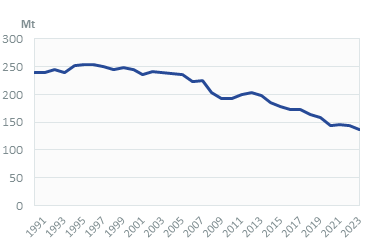
Interactive Chart Japan Refined Oil Products Production
Benefit from up to 2 000 up-to-date data series for 186 countries in Global Energy & CO2 data
Additionally, for more detailed information on refineries, you can request a sample of our Asia Refineries Dataset
Natural Gas Consumption
Gas consumption has decreased by around 2.5%/year since 2012 to 98 bcm in 2023 (25% below its 2012 level). Two thirds of natural gas is used for power generation.
Graph: NATURAL GAS CONSUMPTION (bcm)

Graph: GAS CONSUMPTION BREAKDOWN BY SECTOR (2023, %)
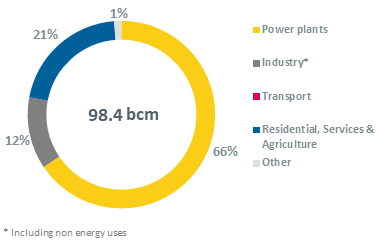
Interactive Chart Japan Natural Gas Domestic Consumption
Benefit from up to 2 000 up-to-date data series for 186 countries in Global Energy & CO2 data
Additionally, for more detailed information on the LNG trade, you can request a sample of our Asia LNG Trade Dataset
Coal Consumption
Coal consumption dropped by 9% in 2023 to 163 Mt. After a rise between 1990 and 2007, coal consumption has been slowly declining between 2013 and 2022 (-1.1%/year).
Electricity production absorbs 63% of the coal demand; the rest is mainly linked to steel production: 19% is used in coking plants and blast furnaces and 18% industry, half of which for steel.
Graph: COAL CONSUMPTION (Mt)
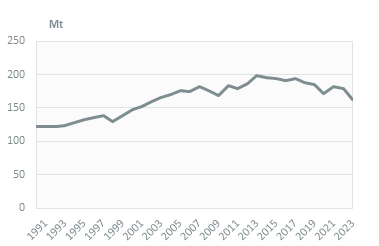
Graph: COAL CONSUMPTION BREAKDOWN BY SECTOR (2023, %)
Interactive Chart Japan Coal and Lignite Domestic Consumption
Benefit from up to 2 000 up-to-date data series for 186 countries in Global Energy & CO2 data
View the detailed consumption trends at country level (graphs, tables, analysis) in the Japan energy report
Power Consumption
Electricity consumption has been slowly decreasing since 2010 (-1.1%/year on average), reaching 909 TWh in 2023, which is 22% below its 2010 level.
Graph: ELECTRICITY CONSUMPTION (TWh)
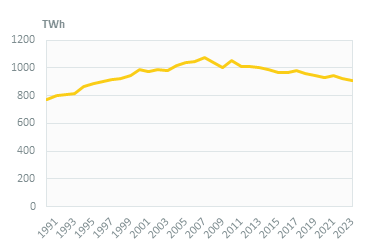
Industry accounts for 36% of electricity consumption, followed by services (34%) and households (26%).
Graph: ELECTRICITY CONSUMPTION BREAKDOWN BY SECTOR (2023, %)
Renewable in % Electricity Production
The 6th Strategic Energy Plan (2021) aims to raise the share of renewables in the power mix to 36-38% (including hydropower) in 2030, with plans to make renewables the main power source in 2050 (27.5% in 2023).
Feed-in tariffs (FiTs) were removed in 2020 for large solar PV (>250 kW), in 2023 for wind (>50 kW) and replaced by a tendering program initiated by METI. They were introduced for solar PV in 2009 (for surplus electricity production only) and for other renewables in 2011. Four auctions are expected for solar PV in 2024.
Interactive Chart Japan Share of Renewables in Electricity Production (incl hydro)
Benefit from up to 2 000 up-to-date data series for 186 countries in Global Energy & CO2 data
Learn more about renewables in the Mini grid Africa & Asia markets for village electrification
CO2 Fuel Combustion/CO2 Emissions
In 2021, Japan raised its NDC target from a 26% reduction in GHG emissions by 2030 to 46% (2013 as base year).
GHG emissions declined by 2.5% in FY2022 to 1.13 MtCO2eq. This represents a 19% decrease compared to FY 2013 (around 42% of the 2030 target). GHG emissions had remained stable in 2021 after a 5.4% drop in 2020, during Covid.
The long-term goal, announced in 2019 in the long-term growth strategy under the Paris Agreement, is to become carbon neutral in 2050.